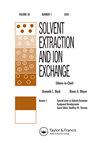苯基取代TODGAs的γ辐射分解:第一部分
IF 2.1
4区 化学
Q3 CHEMISTRY, MULTIDISCIPLINARY
引用次数: 1
摘要
摘要研究了N,N,N’,N’-四辛基二甘醇酰胺(TODGA)的三种苯基化类似物的辐解稳定性:2-(二正辛基氨基)-2-氧代乙氧基)-N,N-二正辛基-2-苯基乙酰胺(PhTODGA),其具有与中心亚甲基结合的苯基取代基,其还包含在醚部分的另一侧与亚甲基结合的甲基取代基,以及2-(2-N-正己基-N-苯基氨基)-2-氧代乙氧基)-N-正己基-N-N-苯基乙酰胺(DHDPDGA),其具有位于酰胺基团而不是中心亚甲基上的苯基取代基。本系列论文第一部分的目的是评估当在a)正十二烷和b)正十二烷基中,在含硝酸的水相存在下辐照时,苯基对这些二甘醇酰胺的辐解稳定性的贡献。结果表明,与未取代的TODGA相比,苯基的存在降低了总的辐解稳定性。然而,结果也表明,与仅在正十二烷中照射相比,苯基以协同方式与硝酸相互作用,增强了苯基化二甘醇酰胺(DGA)衍生物在含硝酸水相存在下的辐射稳定性。结果与假设的在正十二烷相中形成的硝酸-苯基化DGA复合物一致,与单独的苯基化DGA分子相比,该复合物相对于伽马辐射明显更稳定。本文章由计算机程序翻译,如有差异,请以英文原文为准。
Gamma Radiolysis of Phenyl-Substituted TODGAs: Part I
ABSTRACT The radiolytic stabilities of three phenylated analogs of N,N,N’,N’-tetraoctyl diglycolamide (TODGA) were investigated: 2-(2-(di-n-octylamino)-2-oxoethoxy)-N,N-di-n-octyl-2-phenylacetamide (PhTODGA), which has a phenyl substituent bound to a central methylene, 2-(2-(di-n-octylamino)-2-oxo-1-phenylethoxy)-N,N-di-n-octylpropanamide (PhMeTODGA), which also contains a methyl substituent bound to the methylene on the other side of the ether moiety, and, 2-(2-N-n-hexyl-N-phenylamino)-2-oxoethoxy)-N-n-hexyl-N-phenylacetamide (DHDPDGA), which has phenyl substituents located on the amide groups instead of the central methylenes. The objective of Part I of this series of papers covers was to evaluate the contribution of the phenyl group to the radiolytic stability of these diglycolamides when irradiated in a) n-dodecane, and b) n-dodecane in the presence of a nitric acid-containing aqueous phase. The results indicate that the presence of the phenyl group decreases the overall radiolytic stability compared to unsubstituted TODGA. However, the results also indicate that the phenyl groups interact with nitric acid in a cooperative fashion that enhances the radiation stability of the phenylated diglycolamide (DGA) derivatives in the presence of a nitric acid-containing aqueous phase compared to irradiation in only n-dodecane. The results are consistent with the hypothesized formation of nitric acid-phenylated DGA complexes in the n-dodecane phase that are significantly more stable with respect to gamma irradiation, compared to the phenylated DGA molecules alone.
求助全文
通过发布文献求助,成功后即可免费获取论文全文。
去求助
来源期刊
CiteScore
4.40
自引率
5.00%
发文量
15
审稿时长
8.4 months
期刊介绍:
Solvent Extraction and Ion Exchange is an international journal that publishes original research papers, reviews, and notes that address all aspects of solvent extraction, ion exchange, and closely related methods involving, for example, liquid membranes, extraction chromatography, supercritical fluids, ionic liquids, microfluidics, and adsorption. We welcome submissions that look at: The underlying principles in solvent extraction and ion exchange; Solvent extraction and ion exchange process development; New materials or reagents, their syntheses and properties; Computational methods of molecular design and simulation; Advances in equipment, fluid dynamics, and engineering; Interfacial phenomena, kinetics, and coalescence; Spectroscopic and diffraction analysis of structure and dynamics; Host-guest chemistry, ion receptors, and molecular recognition.

 求助内容:
求助内容: 应助结果提醒方式:
应助结果提醒方式:


